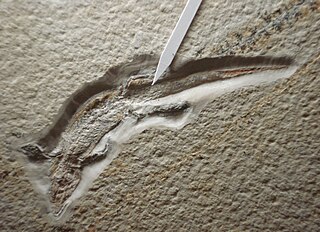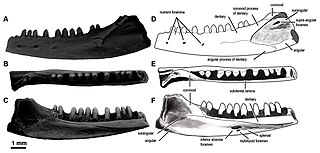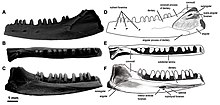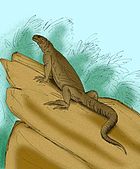
Sauroposeidon is a genus of sauropod dinosaur known from several incomplete specimens including a bone bed and fossilized trackways that have been found in the U.S. states of Oklahoma, Wyoming, and Texas.

Tenontosaurus is a genus of iguanodontian ornithopod dinosaur. It had an unusually long, broad tail, which like its back was stiffened with a network of bony tendons.
The Antlers Formation is a stratum which ranges from Arkansas through southern Oklahoma into northeastern Texas. The stratum is 150 m (490 ft) thick consisting of silty to sandy mudstone and fine to coarse grained sandstone that is poorly to moderately sorted. The stratum is cemented with clay and calcium carbonate. In places the sandstone may be conglomeratic or ferruginous.

Scincomorpha is an infraorder and clade of lizards including skinks (Scincidae) and their close relatives. These include the living families Cordylidae, Gerrhosauridae, and Xantusiidae, as well as many extinct taxa. Other roughly equivalent terms include the suborder Scinciformata, or the superfamily Scincoidea, though different authors use these terms in a broader or more restricted usage relative to true skinks. They first appear in the fossil record about 170 million years ago, during the Jurassic period.
Eromangasaurus is an extinct genus of elasmosaurid known from northern Queensland of Australia.
Paramacellodus is an extinct genus of scincomorph lizards from the Early Cretaceous of England and France, and the Late Jurassic of Portugal and the western United States. The type species, Paramacellodus oweni, was named in 1967 from the earliest Cretaceous (Berriasian) Purbeck Group in Dorset, England. Additional material referable to a species of Paramacellodus, possibly P. oweni, has been described from the Morrison Formation, specifically in Como Bluff, Wyoming, and Dinosaur National Monument, Utah. An indeterminate species is known from the Berriasian aged Angeac-Charente bonebed in France. Paramacellodus belongs to an extinct family of scincomorphs called Paramacellodidae, which spanned most of Laurasia during the Late Jurassic and Early Cretaceous and represented one of the earliest evolutionary radiations of lizards.

Huehuecuetzpalli mixtecus is an extinct lizard from the Early Cretaceous Tlayúa Formation in Tepexi de Rodríguez, Central Mexico. Although it is not the oldest known lizard, Huehuecuetzpalli may be amongst the most basal members of Squamata, making it an important taxon in understanding the origins of squamates.

Marmoretta is an extinct genus of small lepidosauromorph reptile known from the Middle Jurassic (Bathonian) of Britain, as well as the Late Jurassic of Portugal. It contains a single species, Marmoretta oxoniensis.
Paluxysuchus is an extinct genus of neosuchian crocodyliform known from the Early Cretaceous Twin Mountains Formation of north-central Texas. It contains a single species, Paluxysuchus newmani. Paluxysuchus is one of three crocodyliforms known from the Early Cretaceous of Texas, the others being Pachycheilosuchus and an unnamed species referred to as the "Glen Rose Form". Paluxysuchus has a long, flat skull that is probably transitional between the long and narrow skulls of many early neosuchians and the short and flat skulls of later neosuchians.
Calanguban is an extinct genus of scincomorph lizard from the Early Cretaceous of South America. The type species Calanguban alamoi was named in 2014 from the Crato Formation of Brazil and is the oldest known non-iguanian lizard from the continent. It likely had an arboreal lifestyle.
Atokasaurus is an extinct genus of scincomorph lizard from the Early Cretaceous of Oklahoma. The type and only species is Atokasaurus metarsiodon, named in 2002 on the basis of a single isolated lower jaw bone found within the Antlers Formation in Atoka County. It is similar in appearance to extinct lizards in the family Paramacellodidae and may itself be a paramacellodid, although the phylogenetic relationships of the group are uncertain. Atokasaurus differs from other paramacellodids in having teeth in the lower jaw with enlarged bases and an S-shaped profile when viewed edge-on.
Ptilotodon is an extinct genus of teiid lizard from the Early Cretaceous of Oklahoma. The type and only known species is Ptilotodon wilsoni, named in 2002 on the basis of a single lower jaw with four teeth found in the Antlers Formation. The small size of the specimen may be an indication that it belonged to a juvenile.

Eichstaettisaurus is a genus of lizards from the Late Jurassic and Early Cretaceous of Germany, Spain, and Italy. With a flattened head, forward-oriented and partially symmetrical feet, and tall claws, Eichstaettisaurus bore many adaptations to a climbing lifestyle approaching those of geckoes. The type species, E. schroederi, is among the oldest and most complete members of the Squamata, being known by one specimen originating from the Tithonian-aged Solnhofen Limestone of Germany. A second species, E. gouldi, was described from another skeleton found in the Matese Mountains of Italy. Despite being very similar to E. schroederi, it lived much later, during the Albian stage. Fossils of both species show exceptional preservation due to deposition in low-oxygen marine environments.

Dolichosauridae is a family of Cretaceous aquatic lizards. They are widely considered to be the earliest and most primitive members of Mosasauria, though some researchers have recovered them as more closely related to snakes.
Bicuspidon is an extinct genus of polyglyphanodont lizard known from the Late Cretaceous of North America, Europe and Africa, two species, B. numerosus and B. smikros are known from the Cenomanian of Utah in the Mussentuchit Member of the Cedar Mountain Formation and the Naturita Formation respectively. While B. hatzegiensis is known from the Maastrichtian Sânpetru Formation of Romania and B. hogreli is known from the Cenomanian Kem Kem Beds of Morocco. An indeterminate taxon closely related to B. hatzegiensis referred to as B. aff. hatzegiensis is known from the Santonian Csehbánya Formation of Hungary. The dentition is heterodont, with conical anterior teeth and transversely oriented bicuspid posterior teeth.

Ardeosauridae is an extinct family of lizards known from the Late Jurassic of Germany and North America and Early Cretaceous of Mongolia, with other potential species elsewhere from Europe and Asia over the same time period.
Pseudosaurillus is a genus of extinct lizard from the Early Cretaceous of southern England. The type and only species is Pseudosaurillus becklesi, named in 1967 by R. Hoffstetter limited jaw and tooth material from the Berriasian Lulworth Formation. A large amount of material that was additionally referred to Saurillus by Hoffstetter was reassigned to Pseudosaurillus in 1983 by Estes, but this has since been reclassified within its own genus Parasaurillus by Susan E. Evans and Belinda Searle in 2002. The taxon was found in the Mammal Bed near the base of the formation alongside the other lizards Becklesius, Dorsetisaurus, Durotrigia, Paramacellodus, Parasaurillus, Parviraptor and Saurillus. Like Becklesius, Pseudosaurillus may be a member of the family Paramacellodidae.

Tamaulipasaurus is an extinct genus of lepidosauromorph reptile from the Early Jurassic of Mexico. It contains a single species, Tamaulipasaurus morenoi, which is based on skull material found at Huizachal Canyon, a productive fossil site in the La Boca Formation. Tamaulipasaurus had an unusual condensed skull similar to that of amphisbaenians, a modern group of burrowing squamates. It also possessed a variety of plesiomorphic ("primitive") skull features indicating that it was not a true squamate. Nevertheless, other traits do support a position close to squamates, within the broader reptile group Lepidosauromorpha.

Sciroseps is an extinct genus of scincomorph squamates known from a partial left mandible, UA-2016-13-294, from the Early Cretaceous (Albian) Holly Creek Formation of the Trinity Group in Arkansas, USA. The type and only species is Sciroseps pawhuskai. Its generic name is derived from Greek "σκυρος: skiros" (gypsum), and "σεπος: sepos" ; and its species name refers to historic Osage chief Pawhuska.
















